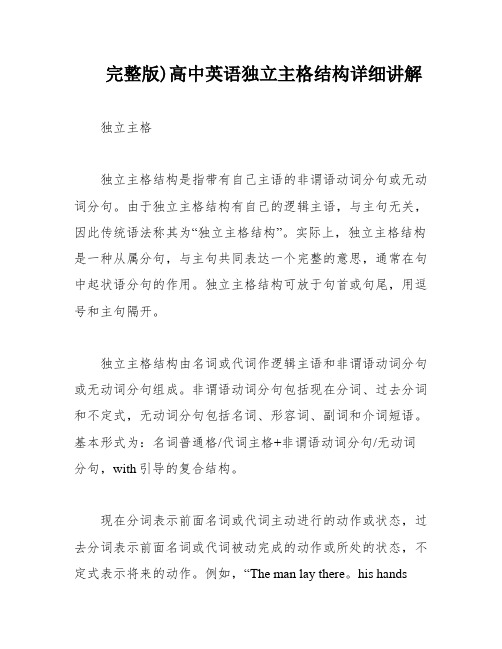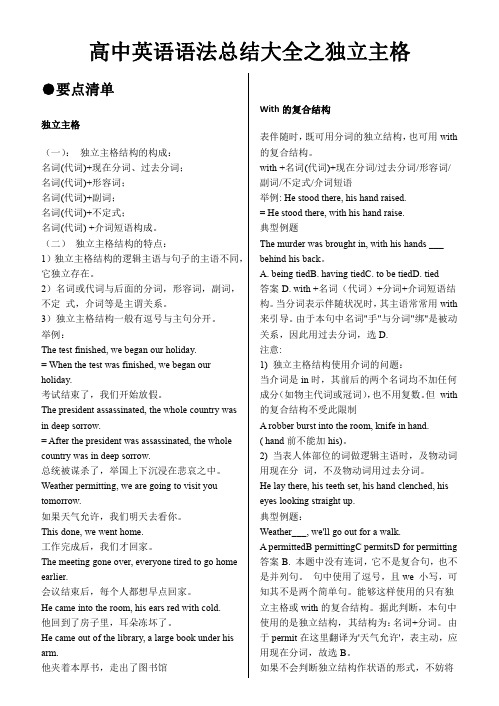高中英语语法精讲第8章独立主格结构.pdf
- 格式:pdf
- 大小:244.87 KB
- 文档页数:8

完整版)高中英语独立主格结构详细讲解独立主格独立主格结构是指带有自己主语的非谓语动词分句或无动词分句。
由于独立主格结构有自己的逻辑主语,与主句无关,因此传统语法称其为“独立主格结构”。
实际上,独立主格结构是一种从属分句,与主句共同表达一个完整的意思,通常在句中起状语分句的作用。
独立主格结构可放于句首或句尾,用逗号和主句隔开。
独立主格结构由名词或代词作逻辑主语和非谓语动词分句或无动词分句组成。
非谓语动词分句包括现在分词、过去分词和不定式,无动词分句包括名词、形容词、副词和介词短语。
基本形式为:名词普通格/代词主格+非谓语动词分句/无动词分句,with引导的复合结构。
现在分词表示前面名词或代词主动进行的动作或状态,过去分词表示前面名词或代词被动完成的动作或所处的状态,不定式表示将来的动作。
例如,“The man lay there。
his handstrembling.”,“So many students being ab sent。
the meeting had to be put off.”,“The boy lay on his back。
his hands crossed under his head.”,“He suggested going for a ic。
Mary to provide the food.”。
在独立主格结构中,being或havingbeen有时可以省略。
These are the first two books。
and the third one is set to be released next month。
We will gather at 7:30.and the n will XXX 8.Many people。
including women and children。
joined in the work。
He XXX。
The XXX。
so we had to wait outside for a while。

《独立主格结构》讲义一、什么是独立主格结构在英语语法中,独立主格结构是一个比较特殊且重要的语法点。
简单来说,独立主格结构是由“名词或代词+现在分词、过去分词、形容词、副词、不定式、介词短语等”构成,在句中作状语,表示时间、原因、条件、伴随等情况。
它与句子的主语没有直接的语法关系,自身有独立的逻辑主语。
这一特点使得独立主格结构在表达上更加灵活多样,能够丰富句子的结构和含义。
二、独立主格结构的构成形式1、名词/代词+现在分词这种形式中,名词或代词是现在分词的逻辑主语,现在分词表示主动和正在进行的动作。
例如:The weather being fine, we decided to go for a picnic (天气很好,我们决定去野餐。
)在这个句子中,“the weather”是“being fine”的逻辑主语,“天气好”这个动作是主动进行的。
2、名词/代词+过去分词此时,名词或代词是过去分词的逻辑主语,过去分词表示被动和完成的动作。
比如:The work done, he went home (工作完成了,他回家了。
)“the work”是“done”的逻辑主语,“工作被完成”是被动的。
3、名词/代词+形容词这种结构中,形容词说明名词或代词的特征或状态。
例如:He came into the room, his face red (他走进房间,脸红红的。
)“his face”是“red”的逻辑主语,“红”描述了“脸”的状态。
4、名词/代词+副词副词在独立主格结构中用于修饰名词或代词。
比如:The meeting over, they went home (会议结束了,他们回家了。
)“the meeting”是“over”的逻辑主语,“over”表示“会议”的结束状态。
5、名词/代词+不定式当名词或代词是不定式的逻辑主语时,常用这种形式。
例如:A lot of work to do, he had to stay up late (有很多工作要做,他不得不熬夜。



高中英语语法总结大全之独立主格●要点清单独立主格(一):独立主格结构的构成:名词(代词)+现在分词、过去分词;名词(代词)+形容词;名词(代词)+副词;名词(代词)+不定式;名词(代词)+介词短语构成。
(二)独立主格结构的特点:1)独立主格结构的逻辑主语与句子的主语不同,它独立存在。
2)名词或代词与后面的分词,形容词,副词,不定式,介词等是主谓关系。
3)独立主格结构一般有逗号与主句分开。
举例:The test finished,we began our holiday.=When the test was finished,we began our holiday.考试结束了,我们开始放假。
The president assassinated,the whole country was in deep sorrow.=After the president was assassinated,the whole country was in deep sorrow.总统被谋杀了,举国上下沉浸在悲哀之中。
Weather permitting,we are going to visit you tomorrow.如果天气允许,我们明天去看你。
This done,we went home.工作完成后,我们才回家。
The meeting gone over,everyone tired to go home earlier.会议结束后,每个人都想早点回家。
He came into the room,his ears red with cold.他回到了房子里,耳朵冻坏了。
He came out of the library,a large book under his arm.他夹着本厚书,走出了图书馆With的复合结构表伴随时,既可用分词的独立结构,也可用with 的复合结构。
with+名词(代词)+现在分词/过去分词/形容词/副词/不定式/介词短语举例:He stood there,his hand raised.=He stood there,with his hand raise.典型例题The murder was brought in,with his hands___ behind his back。

(完整版)独立主格结构完整讲解独立主格结构的用法一、独立主格结构的概念独立主格结构(Absolute Structure)是由名词或代词加上分词等构成的一种独立结构,用于修饰整个句子。
独立主格结构中的名词或代词与其后的分词等构成逻辑上的主谓关系。
这种结构与主句不发生句法上的联系,它的位置相当灵活,可置于主句前、主句末或主句中,常由逗号将其与主句分开。
在句中作状语,相当于一个状语从句。
需特别注意的是,独立主格结构与主句之间不能使用任何连接词。
二、独立主格结构基本构成形式名词(代词)+现在分词;过去分词;形容词;副词;不定式;名词;介词短语)1. 名词(代词)+现在分词例句:The storm drawing near,the navvy decided to call it a day.The storm drawing near在句中作:原因状语=Since the storm was drawing near,the navvy decided to call it a day.由于暴风雨即将来临,那个挖土小工决定收工。
(call it a day 今天到此为止)例句:Winter coming, it gets colder and colder.Winter coming在句中作:伴随状语= The winter comes, and it gets colder and colder.冬天来了,天气越来越冷了。
造句:时间允许的话,我就和你一起走。
Time permitting, I will go with you. 独立主格作:条件状语=改写:If time permits, I will go with you.造句:那个姑娘望着他,他不知道说什么好。
The girl staring at him, he didn’t know what to say.独立主格作:时间状语=改写:As the girl stared at him, he didn’t know what to say.2. 名词(代词)+过去分词例句:He was listening attentively in class, his eyes fixed on the blackboard.他上课专心听讲,眼睛紧盯着黑板。
独立主格结构“独立主格结构”(absolute construction)又叫“独立结构”。
由于在语法上有自己的逻辑主语,结构上与主句不发生关系,因此传统语法叫做“独立主格结构”。
独立主格结构可放于句首、句尾,用逗号和主句隔开。
(一)独立主格结构形式独立主格结构可以分为两部分,形式为:基本形式是:名词普通格/代词主格+现在分词/过去分词/不定式/名词/形容词/副词/介词短语。
1.名词/代词+ 现在分词现在分词表示前面的名词或代词主动进行的动作或状态等。
例:The man lay there, his hands trembling.So many students being absent, the meeting had to be put off.注:“独立结构”中的being或having been 有时可以省去,形成一种名词或代词+名词、形容词、副词、介词短语的结构形式。
2.名词/代词+过去分词过去分词表示前面的名词或代词被动完成的动作或所处的一种状态。
例:The boy lay on his back, his hands crossed under his head.The job not finished, we couldn’t see the film.Her shirt caught on a nail, she could not move.3.名词/代词+不定式不定式表示的是将来的动作。
These are the first two books, the third one to come out next month.We shall get together at 7:30, the procession(游行)to start moving at 8 sharp.4. 名词/代词+名词名词一般做前面名词或代词的同位语。
例:Many people joined in the work, some of them women and children.He fought the tiger,a stick his only weapon.5.名词/代词+形容词短语形容词(短语)说明前面名词或代词的性质,状态,原因等。
2022高中英语语法精炼-第八章独立主格结构一、动词独立主格结构“逻辑主语+being+其他”是独立主格结构中的“逻辑主语+动词-ing形式”的一种形式。
在这种结构中,being往往能够被省去,这种省去being的结构,称之为无动词“独立主格结构”。
A.逻辑主语+名词Ten students entered for the competition, the youngest a boy of 12.十个学生报名参加了这次竞赛,年纪最小的是个12岁的男孩。
(the youngest 和a boy of 12之间省去了being)注意:独立主格结构中的being在下列两种情形下一样不能省略,一是在“There being +名词”结构中,二是在逻辑主语是代词的情形下。
There being no bus, we had to walk home.由于没有公共汽车,我们只好走回家。
It being Sunday, all the offices are closed. 因为是星期日,所有办公室都关门。
B.逻辑主语+形容词He turned to me, his eyes sleepy.他睡眼惺忪地转向我。
(his eyes和sleepy之间省去了being)= He turned to me, and his eyes were sleepy.He stood there, his mouth wide open.他站在那儿,嘴张得大大的。
(his mouth和wide open之间省去了being)= He stood there, and his mouth was wide open.C.逻辑主语+副词School over, we all went home.放学了,我们都回家了。
(school和over之间省去了being)= School was over, and we all went home.He sat at his desk, his shoes off.他坐在课桌旁,没穿鞋子。
第八章独立主格结构非谓语动词作状语时,它的逻辑主语应该是句子的主语。
但有时非谓语动词带有自己的主语,从而在结构上与主语不发生关系,我们称之为独立主格结构(Absolute Construction)。
其实,所谓“独立主格结构”也并非真正独立,它还是一种从属的结构。
一、非谓语动词独立主格结构在独立主格结构中,非谓语动词和它前面的名词或代词存在着逻辑上的主谓关系。
Such an able man to help you,you will surely succeed sooner or later.有这么能干的人来帮你, 你迟早一定会成功的。
(such an able man和to help you 之间存在着主谓关系)= Since such an able man will help you, you will surely succeed sooner or later.He seating himself at the desk, his mother began to tell him a story.他在书桌旁坐好后,他母亲开始给他讲故事。
(seating himself at the desk拥有了自己的逻辑主语he,注意是“主格”)= When he seated himself at the desk, his mother began to tell him a story.The key to the bike lost, he had to walk to school.由于丢了自行车钥匙,他只好步行去学校。
(lost 的逻辑主语是the key,lost 也可以用完成式having been lost)= Because the key to the bike had been lost, he had to walk to school.A.不定式“独立主格结构”在“逻辑主语+动词不定式”结构中,动词不定式和它前面的名词或代词存在着逻辑上的主谓关系。
高中英语语法精讲第八章独立主格结构非谓语动词作状语时,它的逻辑主语应该是句子的主语。
但有时非谓语动词带有自己的主语,从而在结构上与主语不发生关系,我们称之为独立主格结构(Absolute Construction)。
其实,所谓“独立主格结构”也并非真正独立,它还是一种从属的结构。
一、非谓语动词独立主格结构在独立主格结构中,非谓语动词和它前面的名词或代词存在着逻辑上的主谓关系。
Such an able man to help you,you will surely succeed sooner or later.有这么能干的人来帮你,你迟早一定会成功的。
(such an able man和to help you之间存在着主谓关系)= Since such an able man will help you, you will surely succeed sooner or later.He seating himself at the desk, his mother began to tell him a story.他在书桌旁坐好后,他母亲开始给他讲故事。
(seating himself at the desk拥有了自己的逻辑主语he,注意是“主格”)= When he seated himself at the desk, his mother began to tell him a story.The key to the bike lost, he had to walk to school.由于丢了自行车钥匙,他只好步行去学校。
(lost的逻辑主语是the key,lost也可以用完成式having been lost)= Because the key to the bike had been lost, he had to walk to school.A.不定式“独立主格结构”在“逻辑主语+动词不定式”结构中,动词不定式和它前面的名词或代词存在着逻辑上的主谓关系。
这种结构也可用一个从句或并列分句来表达。
1.动词不定式用主动的形式在独立主格结构中,动词不定式和它前面的名词或代词存在着逻辑上的主谓关系。
His mother to come tonight,he is busy preparing the dinner.他母亲今晚要来,他正在忙着准备饭菜。
(= As his mother is to come tonight, he is busy preparing the dinner.)——will you go to the concert tonight 你今晚去听音乐会吗?——Sorry. So many exercise-books to check, I really can't afford any time.对不起,有这多的作业要批,我真的抽不出时间。
(=Because I shall check so many exercise-books tonight, I really can't afford any time.)The four of us agreed on a division of labor, each to translate a quarter of the book.我们四人同意分工干,每人翻译全书的四分之一。
(=The four of us agreed on a division of labor and each is to translate a quarter of the book.)Many trees, flowers, and grass to be planted, our newly-built school will look even morebeautiful. 种上许多的树,花和草后,我们新建的学校将看上去更美。
(=If many trees, flowers, and grass are planted, our newly-built school will look even more beautiful.)B.-ing形式“独立主格结构”动词的-ing形式作状语时,其逻辑主语一般应与句子的主语保持一致。
Being ill, he went home.由于生病,他回家了。
(= As he was very ill, he went home.)Seating himself at the desk, he began to read a magazine.在课桌旁坐好后,他开始看杂志。
(= When he had seated himself at the desk, he began to read a magazine.)1.表示时间的-ing形式作“独立主格结构”Everyone being ready, the teacher began his class.每个人都准备好后,老师开始上课。
(相当于一个时间状语从句When everyone was ready)The chairman began the meeting , everyone being seated.每个人坐好后,主席开始开会。
(相当于一个时间状语从句after everyone was seated)2.表示原因的-ing形式作“独立主格结构”The boy leading the way, we had no trouble finding the strange cave.由那个男孩带路,我们没有困难就找到了那奇怪的洞。
(相当于一个原因状语从句Because the boy led the way)Many eyes watc hing him, he felt a bit nervous.许多眼睛看着他,他感到有点儿紧张。
(相当于一个原因状语从句As many eyes were watching him)必背:含有being的独立主格结构。
It being National Day today,the streets are very crowded.今天是国庆节,街上很拥挤。
= As it is National Day today, the streets are very crowded.There being no further business to discuss, we all went home.没有别的事可讨论,我们都回家了。
= As there was no further business to discuss, we all went home.3.表示条件的-ing形式作“独立主格结构”Time permitting, we will have a picnic next week.时间允许的话,我们下星期将进行一次野炊。
(相当于一个条件状语从句If timepermits)My health allowing, I will work far into the night.我的健康许可的话,我愿工作到深夜。
(相当于一个条件状语从句If my health allows)4.表示方式的-ing形式作“独立主格结构”The students are walking in the school happily, each wearing a card in front of his chest.学生们快乐地在学校里走着,每个人胸前都带着一张卡。
(相当于一个并列分句and each wears a card in front of his chest)The boy lay on the grass, his eyes looking at the sky.男孩躺在草地上,眼睛看着天空。
(相当于一个并列分句and his eyes were looking at the sky)C.-ed形式“独立主格结构”与逻辑主语+动词的-ing形式一样,如果-ed形式的逻辑主语和句子的主语不一致的话,就需要用-ed形式的独立主格结构。
The book written in simple English, English beginne rs were able to read it.该书是用简单英语写的,英语初学者也能看懂。
= As the book was written in simple English,English beginners were able to read it.The workers worked still harder, their living conditions greatly improved.由于工人们的生活条件大大提高,他们工作得更起劲了。
= As their living conditions were greatly improved, the workers worked still harder.He was listening attentively in class, his eyes fixed on the blackboard.他上课专心听讲,眼睛紧盯着黑板。
= He was listening attentively in class, and his eyes were fixed on the blackboard.The task completed, he had two months' leave.任务完成以后,他休了两个月的假。
(=When the task had been completed, he had two months' leave.)比较:动词不定式表示动作没有发生或即将发生,动词-ed形式表示动作已经结束,动词-ing 形式往往表示动作正在进行。
The manager looks worried,many things to settle.经理看上去很着急,有这么多的事情要处理。
(事情还没有处理,而且是由经理本人来处理,用不定式to settle)The manager looks relaxed, many things settled.许多事情已经处理好了,经理看上去很轻松。
(事情已经处理好了,用动词-ed形式settled表示动作已经结束)The food being cooked, the boy was watching TV.小孩一边做饭,一边看电视。
(两个动作同时进行)The food cooked, the boy went to bed. 饭做好了,小孩去睡了。